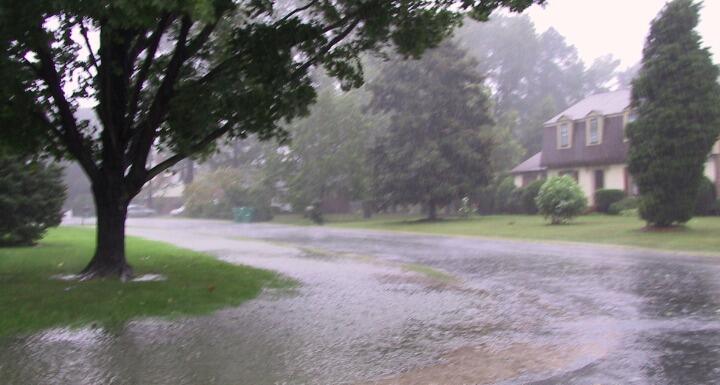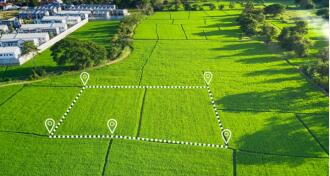Many homeowners in North Carolina experience issues with excessive surface water flow and localized nuisance flooding after rain events.
How communities deal with these problems was the focus of Ward and Smith's latest Community Association Building Blocks webinar for community association managers, landowners, and community association board members.
Over the last several years, the frequency and intensity of rain events increasingly have impacted planned communities. An overview of drainage and stormwater can help with perspective.
Surface water flow in a community typically is addressed first by a developer's design for the community. The flow of water is addressed in a variety of plans and documents, such as:
- Drainage Plans – designed to direct the flow of water throughout the community
- Erosion and Sedimentation Control Plans - designed to contain and manage soil disturbed during construction to keep it from washing into surface waters
- Construction Stormwater Permits - designed to prevent runoff of soil, chemicals, and sediment into surface water during and after rain events while the project is under construction
Once a development is completed, post-construction management of surface water flow often ends up in the purview of a community association, such as a homeowners' or property owner' association ("Association"), through different provisions in permits, in covenant language, or within recorded easement agreements and identified as drainage and/or stormwater. Although this begins with the developer's plans, it ends with an Association's management of the completed development in the community. An Association will need to understand the terms not only for common areas it owns but to manage activities within its authority as outlined in governing documents.
Regulatory Controls
Although used interchangeably in casual conversation, there are important differences between the regulation of surface water flow and stormwater. Drainage of surface water primarily is a local concern governed by ordinances and building permit schemes within a county or city with jurisdiction over a drainage basin (local rivers, tributaries, etc.). Plans for drainage have features that address surface water direction of flow after grading and completion of development to allow for predictability of surface water flow from rain events or man-made irrigation and to manage the ability of the drainage basin system to store water. Although stormwater looks similar to drainage because a rain event generates flow, the regulation has a different goal. Stormwater management is intended to prevent pollutants in the flow from impacting surface water resources, whereas drainage plans address the volume and the direction of the flow, but not what's actually in the flow.
There can be substantial overlap between governmental bodies and ordinances that manage stormwater and drainage. The two issues must be separately addressed since they are different. The enforcement mechanisms also vary depending on whether the obligations are in a permit that stands alone or in a recorded agreement, such as restrictive covenants and easement agreements.
The terms in a document addressing stormwater are designed to control the amount of impervious surface or built-upon area ("BUA") that can be constructed in a community. Undeveloped vegetative space helps control the velocity of stormwater runoff and allows the water to infiltrate into the soil where pollutants are captured. Geographic location often determines what regulatory scheme will control. Certain areas, including the 20 coastal counties, are subject to the State Stormwater Permit Program administered by the North Carolina Department of Environmental Quality Division of Energy Mineral and Land Resources ("DEMLR"). Under that program, there are two types of residential permits, low density, and high density. For low density, 12 to 25 percent of the project area can be developed with BUA to retain enough green space for stormwater infiltration to occur.
Higher density communities may be developed with more BUA but will need to utilize engineered stormwater control measures, such as ponds, to treat the additional stormwater runoff resulting from more impervious surfaces. Unlike low density stormwater permits, which do not expire, high density permits must be renewed every eight years. As part of the permit renewal process, inspections have to be done to ensure the stormwater control measures are still functioning as designed.
When a residential subdivision project is completed, the management of stormwater often shifts to the Association. For properties in an area with local easement agreements, the obligations will do so automatically when the property is conveyed. If the property is in an area governed by a state stormwater permit, a formal transfer process is required by statute and regulation. Once the common areas have been conveyed to the Association, and the Association no longer is controlled by the developer, a transfer request application must be submitted to DEMLR. The agency will inspect the development to confirm the stormwater management system is in compliance before it transfers the permit. The Association will need to understand and follow the terms of the permit and any related provisions in its governing documents.
Association members and managers should be aware that new provisions regarding the transfer of State Stormwater Permits began in September 2021 with revisions to the North Carolina General Statutes.
Liability Issues
North Carolina allows landowners to change the surface water flow on their property. A variety of liability issues can arise when adjoining properties experience flooding as a result of landowners performing grading, changing vegetation, or altering drainage channels.
There are several theories that govern the liability of surface water flow:
- Common Enemy Rule - surface water is a common enemy to all landowners
- A landowner can do what is necessary to address issues with surface water
- A landowner has no liability to adjoining landowners for property damage resulting from alterations to surface water flow
- Civil Law Rule – a landowner is liable to another when adjoining property is damaged due to alterations in the flow of surface water
- North Carolina followed the Civil Law Rule until 1977 when a specific case prompted reconsideration
Part of the reason for reconsideration was that North Carolina was already following a number of exceptions to the Civil Law Rule. A notable exception was made for municipal construction, including street construction. Essentially, the courts found that even though the construction of a street may result in increased runoff that could cause damage to an adjoining property, the street is something that is built for the public good. So, any potential damage to adjoining property would be outweighed by the benefits the community gained from having the roadway, as long as the roadway was built using sound engineering techniques and was not found to be negligently constructed.
This exception and other reasons led the North Carolina Supreme Court to adopt the Reasonable Use Rule, which provides the following:
- A landowner can make reasonable use of property even if it results in harm to an adjoining landowner
- Liability can occur if the interference is unreasonable and causes substantial damage to the adjoining property
Basically, landowners must take reasonable care to avoid causing unnecessary harm to adjoining landowners. The Court indicated that in some cases, the gravity of the harm to the adjoining landowner might be so significant that compensation is required, regardless of whether the conduct of the defendant was reasonable under the circumstances.
So, how do the courts determine if a use was reasonable or not? The courts will review a number of factors to determine whether a landowner exercised reasonable care. The factors considered by the courts include:
- Whether the action was intentional, unreasonable, negligent, or reckless
- The extent and character of the harm versus the social value of the use (the purpose of the use)
- Whether the action taken is typical or suitable for the locality
- Whether the landowner took reasonable steps to minimize damage caused by the change
Other factors that the courts will consider are whether the action taken by a landowner violates any federal, state, or local laws, easement agreements, or restrictive covenants that govern the land. For example, if a developer gets approval for a site plan and then makes unauthorized changes to the plan, the developer may be liable for any damage to adjoining properties that result from changes to the natural flow of surface water.
When a developer transfers streets, drainage ditches, retention/detention ponds, and other common areas to a homeowners association, the association becomes responsible for the control, operation, repair, maintenance, and upkeep of those areas. When determining whether an association will be liable for drainage issues, the restrictive covenants will be an essential part of the review. Since restrictive covenants are contracts, they often are interpreted as a matter of law. The Court will look at the "four corners of the document and will attempt to determine the intent of the drafter at the time the covenant was created. Covenants are usually strictly construed—meaning that any doubt is resolved in favor of the free use of the land and against the restriction—but the courts can find implied rights or obligations.
The courts will also consider the following:
- Whether the drainage areas and stormwater infrastructure are common areas maintained by the Association
- Whether the Association has been using regular or special assessments to maintain and repair the common areas and/or mitigate drainage issues
The bottom line is that a homeowners association may be responsible for drainage issues and legal disputes that come up, but there are a lot of factors and a lot of reasons why they may not be. Some common causes of action in association cases include breach of fiduciary duty, breach of contract or covenants, nuisance, negligence, and/or trespass.
When making decisions about stormwater or drainage issues, community association directors do not have to be right to avoid liability. However, they do have to discharge their duties in good faith, with due care and loyalty to the Association. A good rule of thumb for community association directors is to be transparent, reasonable, accessible, and positive to minimize liability.








